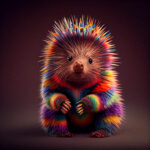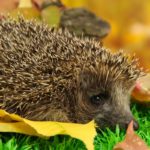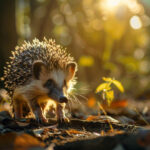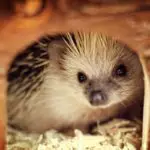
Discover the truth about porcupine quills and their defensive capabilities in this enlightening read!
Quick Answer: Porcupines cannot shoot their quills; they detach upon contact and can only move a short distance, typically inches.
Key Takeaways:
- Porcupines cannot shoot their quills; they detach upon contact with predators, and the quills’ barbed tips make them difficult to remove, providing an effective passive defense mechanism.
- Quills are made of keratin, similar to human hair and nails, and their structure includes a hollow shaft and microscopic barbs; variations in quill length and sharpness among species and individuals are adaptations to different threats.
- In encounters with porcupines, it’s important to maintain a safe distance, recognize defensive behaviors, and know how to remove embedded quills properly to avoid infection and further injury.
Debunking Porcupine Quill Myths
Many people believe that porcupines can shoot their quills at predators or threats. This is a myth. In reality, porcupines cannot launch their quills like projectiles. The confusion likely comes from how easily quills can stick to an animal upon contact. When a predator gets too close, it may end up with quills embedded in its skin, but not because the porcupine shot them out.
From an evolutionary standpoint, a shooting mechanism would be impractical. It would require a significant amount of energy and anatomical adaptations that porcupines do not have. Instead, their defense mechanism is passive but effective. The quills are designed to detach easily and stick to the attacker, not to be actively fired.
Can Porcupines Shoot Their Quills?
During defensive encounters, a porcupine’s behavior is more about intimidation than attack. They may bristle their quills to appear larger and more threatening, but they do not shoot them. The quills are released upon contact. They have barbed tips that penetrate and stay in the skin, making them difficult to remove. This passive defense is a porcupine’s way of deterring predators without the need for aggression.
Understanding the Range of Quill Projection
The quill detachment is not a matter of projection but of contact. A quill can travel only a short distance, typically when it detaches after something or someone touches the porcupine. The force of contact or the angle at which the quills are touched can influence how far a detached quill might move, but it’s usually just a matter of inches.
Comparing the porcupine’s quill release to other animals’ active defense mechanisms shows clear differences. For example, skunks spray their attackers with a foul-smelling liquid, which is an active defense. Porcupine quills, however, rely on the attacker making contact. Despite the lack of active projection, the quills are an effective defense due to their painful penetration and the challenge of removing them.
Dispelling Common Porcupine Quill Misconceptions
There are several other misconceptions about porcupine quills. One is that porcupines can regenerate quills indefinitely. While it’s true that they can grow new quills, there is a limit to how quickly this happens. Quills are not poisonous or venomous; the pain and risk of infection come from the difficulty in removing them and the potential for injury.
Another myth is that porcupines can control which quills are released. In fact, they have no control over this—it’s an involuntary response. Also, environmental factors do not affect quill release. Whether it’s hot or cold, wet or dry, the quills respond the same way to contact.
By understanding these facts, we can appreciate the porcupine’s unique defense system and dispel the myths that have long surrounded these fascinating creatures. The key takeaway is that porcupines do not shoot their quills; they are released upon contact and are designed to deter, not attack.
The Anatomy of Porcupine Quills
Porcupine quills are fascinating structures that serve as the primary defense for these creatures. Each quill is a marvel of nature’s design, made of keratin, the same material found in human hair and nails. The quills are essentially modified hairs, but they are far from ordinary. They are composed of a hollow shaft that makes them light yet strong, and their ends are covered in microscopic barbs. These features make the quills incredibly effective for protection.
Porcupines have different types of quills. The longer guard quills are on the surface, acting as the first line of defense. Beneath these are the softer, shorter hairs known as underfur, which provide insulation. Each type of quill plays a role in the porcupine’s survival, with the guard quills being the primary deterrent against predators.
Structure and Composition of Quills
Delving deeper into the quill’s structure, we find that they are composed of multiple layers of keratin. These layers are tightly packed, giving the quills their rigidity and sharpness. The growth of quills is a continuous process, similar to how our hair and nails grow. This growth ensures that lost or damaged quills are replaced over time.
The barbed design of the quill tips is particularly interesting. These barbs are what make the quills so difficult to remove once they’ve penetrated an attacker’s skin. They hook into the flesh, anchoring the quill and making any movement of the quill painful and damaging, which further deters predators from attacking.
Variations in Quill Length and Sharpness
Quill characteristics can vary widely among porcupine species and even within individual animals. Some quills are longer and sharper, while others may be shorter and more blunt. These variations are adaptations to different environments and threats. For example, a porcupine that faces larger predators may have evolved longer, sharper quills as a more effective deterrent.
Factors that influence quill development include:
- The porcupine’s age
- Its diet
- Overall health
These factors can affect the strength, length, and density of the quills, which in turn influences how easily they can become embedded in a predator.
How Quills Are Arranged on a Porcupine’s Body
The arrangement of quills on a porcupine’s body is no accident. They are distributed in a way that maximizes defense. Quills are most densely packed on the back and tail, where they are most needed in an encounter with a predator. Porcupines can raise these quills to make themselves appear larger and more intimidating, a clear warning signal to any threat.
Quills are interspersed with the porcupine’s fur, which can vary in color and length. The strategic placement of quills allows porcupines to direct them toward a threat by turning their back or tail towards the predator. This body movement is a critical part of their defense strategy, ensuring that the most vulnerable areas are protected.
Understanding the anatomy of porcupine quills is essential to appreciating how these animals defend themselves. While the quills are not projectiles, their design and the way they are used by the porcupine make them a highly effective deterrent against predators.
Porcupine Defense Mechanisms
Porcupines are equipped with a unique set of tools for self-defense. Their most notable feature, the quills, plays a central role in their protection. However, their defense is not limited to these sharp spikes. Porcupines also use a variety of behaviors to deter potential threats. They may charge backward or sideways to embed quills in a predator, but they also employ vocalizations and posturing to ward off danger before it escalates to physical contact.
How Porcupines Use Quills to Deter Predators
When a porcupine is threatened, it has a series of actions it can take to avoid harm. The animal will often puff up, making its quills stand out more, which serves as a visual warning to predators. If the threat persists, a porcupine might resort to swatting with its tail, where many quills are concentrated, to drive the points home—literally.
The aftermath of a quill embedment is not just immediate pain but also the risk of infection, which acts as a long-term deterrent. Predators learn to associate the porcupine with a painful, potentially life-threatening experience, which makes them think twice before attacking again.
The Role of Quills in Non-Projectile Defense
Porcupines do not need to shoot their quills to use them effectively in defense. The presence of quills alone is a passive defense mechanism. Their texture and coloration can blend into the surroundings, acting as camouflage, or stand out as a stark warning against predators considering an attack.
In social interactions with other porcupines, the animals are careful to avoid injuring each other with their quills. This demonstrates that porcupines are well aware of the potential harm their quills can cause and have adapted their behaviors accordingly.
Behavioral Strategies for Protection
Aside from their physical defenses, porcupines are strategic in their choice of habitat. They prefer environments that offer natural protection, such as rocky outcrops or dense underbrush, where their mobility is not hindered, but predators’ is.
When sensing danger, a porcupine might freeze in place, making it harder to spot. Alternatively, it may seek higher ground, such as climbing a tree, to escape ground-based predators. These behaviors show that porcupines are not just relying on their quills but are also intelligent and adaptable in their approach to staying safe.
What to Do During a Porcupine Encounter
Encountering a porcupine can be an unexpected surprise. Whether you’re hiking in the woods or find one near your home, it’s important to know how to act. Keeping a safe distance is key, as is recognizing when a porcupine feels threatened. If quills become embedded in your skin, there are specific steps for removal, and in some cases, you’ll need medical attention. Let’s walk through how to have a safe and responsible interaction with these spiky creatures.
Safe Observation Distances
To safely observe a porcupine, maintain a distance that ensures you’re out of quill range. While porcupines can’t shoot their quills, they can release them upon contact. Here are some guidelines:
- In the wild: Stay at least 30 feet away.
- In controlled environments, like a zoo: Follow posted safety signs.
Always avoid cornering or surprising a porcupine. These actions can provoke a defensive response, which is something we want to prevent.
Steps to Take if a Porcupine Feels Threatened
If you find yourself too close to a porcupine and it seems agitated, it’s crucial to know how to de-escalate the situation. Look out for signs like quills standing on end, hissing, or stamping feet. These indicate a porcupine is on the defensive. Here’s what to do:
- Slowly back away to give it space.
- Avoid sudden movements or loud noises.
- Do not make direct eye contact, as this can be seen as a challenge.
By following these steps, you can minimize the risk of a quill encounter.
Removing Quills After an Encounter
If quills do become embedded in your skin, prompt and careful removal is necessary. Here’s a step-by-step guide:
- Stay calm and gently restrain the affected area to prevent further embedding.
- Using clean tweezers, firmly grip the quill as close to the skin as possible.
- In one smooth motion, pull the quill straight out to avoid breaking it.
- Clean the area thoroughly with soap and water to prevent infection.
- Apply an antibiotic ointment and cover with a bandage.
If you’re unable to remove the quills or if there’s significant pain and swelling, seek professional medical help immediately. Contrary to popular belief, cutting the end of the quill does not make it easier to remove and can actually cause the quill to splinter, complicating removal.
Understanding these steps ensures that if you ever find yourself in a prickly situation, you’ll know exactly how to handle it safely.
Caring for Porcupines
Caring for porcupines, whether in a wildlife rehabilitation setting or as exotic pets, requires a deep understanding of their needs and behaviors. It’s crucial to handle these animals correctly to prevent quill injuries and to create an environment that promotes their well-being. Additionally, caretakers must be aware of the legal and ethical considerations involved in keeping porcupines. This guide will provide comprehensive insights into the best practices for porcupine care.
Best Practices for Handling Porcupines
Handling porcupines safely is essential for avoiding injuries from their quills. Here are some tips for proper handling:
- Approach a porcupine calmly to avoid startling it.
- Use protective equipment like gloves when necessary.
- Pick up a porcupine by supporting its belly, not by the quills.
- Learn to recognize signs of stress in porcupines, such as quill rattling or hissing.
Understanding porcupine behavior is key to preventing accidents during handling. Always move slowly and with care to keep both you and the porcupine safe.
Providing a Safe Environment for a Porcupine
A safe and stimulating environment is vital for a porcupine’s quality of life. Consider the following when setting up their living space:
- Enclosures should be spacious and secure to prevent escapes.
- Include climbing structures and hiding places to mimic their natural habitat.
- Provide a balanced diet that meets all their nutritional needs.
- Ensure regular veterinary care to monitor their health.
By addressing these needs, you can create a comfortable and enriching environment for your porcupine.
Health Considerations for Porcupines with Quills
Porcupines’ quills are not just defensive tools; they’re also a part of their health. Here are some health considerations related to quills:
- Quill loss or injury can lead to infection or impaired mobility.
- Normal quill shedding is part of their growth cycle.
- Be alert for abnormal quill loss, which could indicate health issues.
Monitoring the condition of a porcupine’s quills is an important aspect of their overall care. Regular checks can help identify any potential problems early on.
Frequently Asked Questions
Question 1:
Can porcupines control the direction of their quills when they are released?
Answer: No, porcupines cannot control the direction; quills detach and may stick to the attacker in the direction of contact.
Question 2:
What is the average number of quills a porcupine has?
Answer: The number varies by species, but a North American porcupine can have over 30,000 quills.
Question 3:
How quickly do porcupines regenerate lost quills?
Answer: Quills regrow over time, but the rate can vary based on the porcupine’s health and age.
Question 4:
Can porcupine quills cause an allergic reaction in humans or animals?
Answer: While not common, some individuals may experience an allergic reaction to the proteins in quills.
Question 5:
Are there any predators that have adapted to successfully hunt porcupines despite their quills?
Answer: Some predators, like fishers, have developed techniques to attack porcupines with minimal risk.
Read more facts about Porcupines here.
Further reading here.









